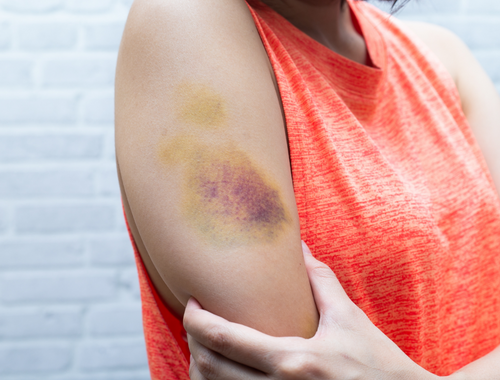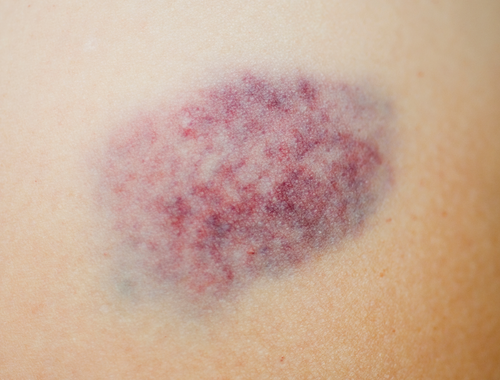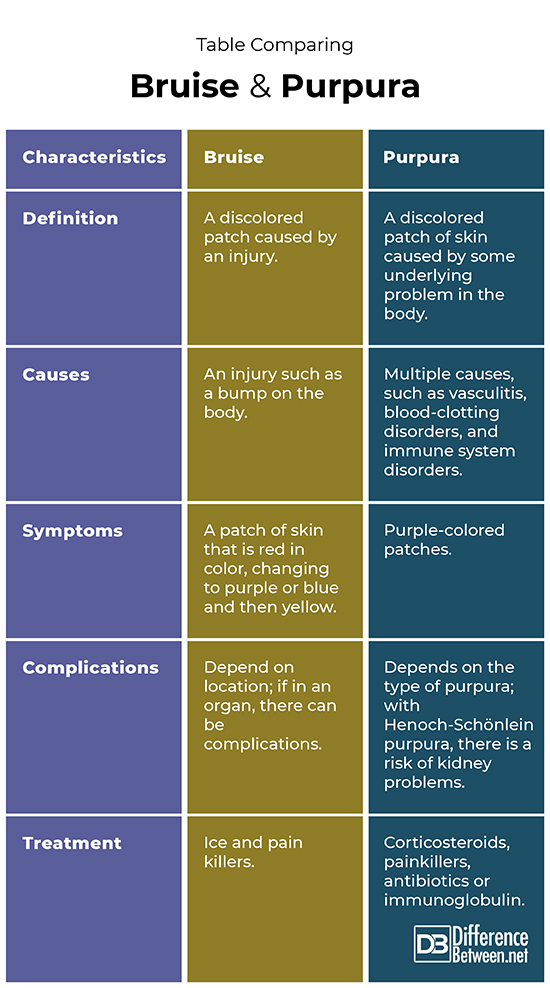Difference Between Bruise and Purpura
A bruise is a small section of tissue that is discolored because of an injury that caused blood to leak out of blood vessels. Purpura is an area of tissue that is purple in color and is also due to bleeding.

What is a Bruise?
Definition:
A bruise is an area of discolored skin or tissue that is due to an injury.
Causes and risk factors:
Bruises happen when there is an injury causing blood vessels to break and blood to leak out under the skin. Risk factors for bruises include having bleeding disorders, a deficiency in vitamin C, and taking anticoagulant medications.
Symptoms and complications:
Bruises appear as red areas that change colors in time to purple, blue, and finally, yellow color. Most bruises will heal without complications. However, large bruises and those in organs like the brain can result in hematoma formation. A hematoma can be dangerous and if in the brain, needs to be treated. People with liver disease or cancer are also more at risk of bruises.
Diagnosis:
A bruise is diagnosed by a physical exam and a history of injury.
Treatment:
A bruise can be treated with painkilling medication and ice if there is swelling in the injured area.

What is Purpura?
Definition:
Purpura is purple-colored lesions found on the skin or on mucous membranes.
Causes and risk factors:
Purpura is due to bleeding from blood vessels. This can be due to inflammation of the blood vessels or platelet, and clotting disorders and infections and an immune response affecting blood vessels. Thrombocytopenic purpura is due to clotting problems, while nonthrombocytopenic purpura is not due to blood clotting problems but could be due to sarcoidosis. Another type, Henoch-Schönlein purpura, is caused by the immune system. The use of certain drugs like warfarin and heparin can also increase the chance of thrombocytopenic purpura. Purpura is also more likely in older people who have had a lot of sun exposure.
Symptoms and complications:
Purpura appears as purple areas of skin. The complications depend on the type and cause of the purpura. For instance, complications of Henoch-Schönlein purpura includes kidney problems.
Diagnosis:
Diagnosis is by physical exam. A biopsy and blood tests can help diagnose the type of purpura. Diagnosing the type of purpura is important if a treatment plan is to be effective.
Treatment:
The treatment option depends on the cause of the purpura, but it may include using corticosteroids or giving intravenous immunoglobulin. Antibiotics and pain relievers may be used as well if there is pain or if the purpura is due to infection.
Difference between Bruise and Purpura?
Definition
A bruise is a discolored patch of skin that is due to an injury. Purpura is a discolored area of skin due to some problem inside the body.
Causes
The cause of a bruise is a traumatic injury like a blow to the body or head. The possible causes of purpura are vasculitis, blood-clotting disorders, and immune system disorders.
Symptoms
The symptom of a bruise is a patch of skin that is red in color, changing to purple or blue and then yellow. The signs of purpura include the presence of purple-colored patches on the skin.
Complications
The complications of a bruise depend on where it is; if the brain is bruised, it can lead to further problems like a hematoma. The complications of purpura depend on the type of purpura; with Henoch-Schönlein purpura, there is a risk of kidney problems.
Treatment
Ice and painkillers are how you treat a bruise. The treatment of purpura depends on the cause but can include the use of corticosteroids, antibiotics, immunoglobulin, and painkillers.
Table comparing Bruise and Purpura

Summary of Bruise Vs. Purpura.
- A bruise is a patch of skin that is discolored because of bleeding under the skin caused by some type of injury where blood vessels have been damaged.
- Purpura are purplish patches on the skin that are due to some underlying disorder or diseases like sarcoidosis or a clotting disorder.
- Bruises often heal on their own unless in the brain.
- Purpura is treated according to the cause of the problem.
FAQ
How do I know if I have purpura?
Only a doctor can diagnose purpura; confirmation of the diagnosis may require a biopsy as well as additional blood tests.
Can a bruise cause purpura?
A bruise does not cause purpura, although they may look similar. A bruise is due to trauma, but purpura is due to some underlying disorder or problems in the body, such as a clotting problem or immune system condition.
What is the difference between purpura and ecchymosis?
Purpura is purple lesions on the skin because of bleeding under the skin, while ecchymosis is a large bruised area where there is bleeding.
What does a purpura look like?
Purpura looks like purple lesions on the skin.
What are the two types of purpura?
The two types of purpura are thrombocytopenic and nonthrombocytopenic purpura. Thrombocytopenic is when the platelet count is abnormal, while nonthrombocytopenic means a normal platelet count.
Does purpura come on suddenly?
Purpura can happen suddenly especially if it is idiopathic (unknown cause) thrombocytopenic purpura.
- Difference Between Rumination and Regurgitation - June 13, 2024
- Difference Between Pyelectasis and Hydronephrosis - June 4, 2024
- Difference Between Cellulitis and Erysipelas - June 1, 2024
Search DifferenceBetween.net :
Leave a Response
References :
[0]Kuter, David J. “Purpura simplex (easy bruising)”. Merckmanuals. Merck & Co., 2022, https://www.msdmanuals.com/professional/hematology-and-oncology/bleeding-due-to-abnormal-blood-vessels/purpura-simplex
[1]Roache-Robinson, P., and D. T. Hotwagner. "Henoch Schonlein purpura (anaphylactoid purpura, HSP)." (2019).
[2]Stephenson, Terence, and Yvona Bialas. "Estimation of the age of bruising." Archives of Disease in Childhood 74.1 (1996): 53-55.
